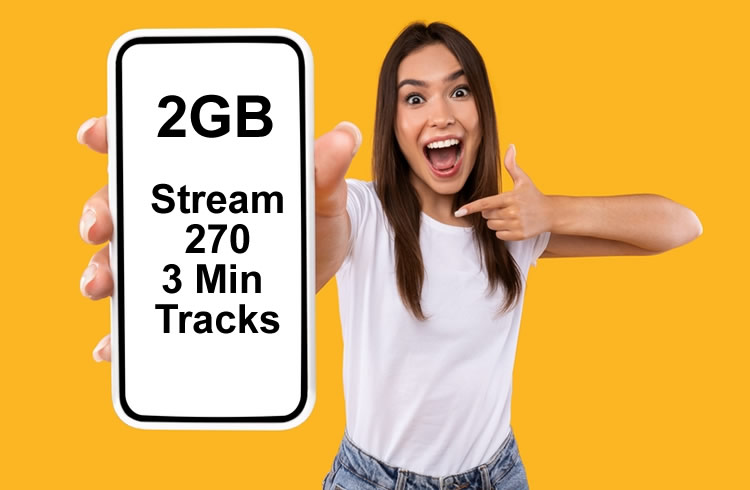
Introduction
The amount you pay for your contract phone or pay-monthly SIM will often depend on several factors, including which provider you choose and how much data you use. We use data for everything from sending messages via internet-connected apps like WhatsApp, to browsing on social media platforms and watching online videos.
Years ago, 2GB of data might have sounded like a hefty sum. But in today’s world, it’s easy to drain 2GB from your account within a matter of hours.
So, how much can you do with 2GB of data? And is a 2GB data plan suitable for your phone needs, or do you need to choose a larger, more extensive plan? Let’s find out.
How Long Does 2GB Of Data Last?
| How Many Hours Will 2GB Last |
|
Internet browsing
|
22 hours
|
|
Music listening
|
Between 13 and 185 hours (depending on quality)
|
|
Watching video
|
Between 0.66 hours and 12 hours (depending on your video app and the video quality)
|
|
Browsing social media
|
22 hours (Scrolling) or 12 hours (interacting)
|
|
Using FaceTime, WhatsApp, or Skype
|
6-11 hours
|
The number of hours your 2GB of data will last will depend on how you’re using your device. On average, these are the kind of hours you can expect, as listed above.
Is 2GB Of Data Enough For The Average Person?
A while ago, 2GB was a popular data option for countless mobile device users. However, according to an Ofcom report covering 2023, people are on average using 7.07GB of mobile data per month now.
In many cases, data use can be even higher, with Three for example finding that its customers used an average of 30GB of data in 2023. So the average person uses a significant amount of data, and a lot more than 2GB.
Whether you need a higher or lower amount of data will depend on the things you use your phone for. However, unless you’re an extremely light user we’d recommend more than 2GB. Check out our ‘how much data do I need?’ guide for more details of other data allowances, or read on below for a more detailed look at how far 2GB will go.
Lebara Mobile SIM Deal
30GB Data
Unlimited Mins
Unlimited Texts
Lyca Mobile SIM Deal
5GB Data
1000 Mins
1000 Texts
Lebara Mobile SIM Deal
50GB Data
Unlimited Mins
Unlimited Texts
Audio Data
|
Songs Streamed on Spotify
|
|
2GB of data
|
270 x 3 minute tracks
|
The average song streamed through an app like Spotify at a quality of approximately 320kbps will require 2.4MB per minute. This means the average song, lasting 3 minutes, will use around 7.2MB of data. This means you can stream around 270 3-minute tracks on Spotify with 2MB. The amount of data you’ll use will depend on the quality of the music, for instance: 24kbps: 10.8MB per hour, 96kbps: 43.2MB per hour, 160kbps: 7.2MB per hour, 320kbps: 144MB per hour.
Video Data
|
Netflix Video Streaming (on phone)
|
|
2GB of data
|
Stream up to around 6 Netflix films
|
The amount of data you’ll use streaming video to your phone will depend on what kind of application you’re using, as well as the quality of the video file.
Netflix claims you can stream about 8 hours of content (around four films) with 2GB of data if you’re watching the content using the ‘Automatic’ quality setting. However, you can switch to ‘Save Data’ mode to increase your streaming length up to around 12 hours. If you switch to the ‘Maximum Data’ setting, you’ll get the best quality but be using around 3GB of data per hour.
The higher the quality of your stream, the more data you’ll need to use. Notably, these figures apply only to the mobile app for Netflix, the desktop or TV version will have different data usage figures.
On YouTube, you should be able to watch around 4 hours of online content in standard definition. YouTube uses around 2.7GB of data per hour in 4K, or 1.56GB per hour in 1080p.
Social Media Data
|
Social Media Use Examples for 2GB Data
|
|
WhatsApp Video Calls
|
3 hours of video chat time
|
|
Apple FaceTime Video Calls
|
4 hours of video chat time
|
|
Photos on WhatsApp
|
Send around 1000 photos
|
Moving over to social media, the amount of data you use will depend on what you’re going to be doing on your social media platform. If you’re simply browsing through social media channels like Facebook or Instagram, you’ll use around 90MB per hour on scrolling alone.
If you’re interacting with social media content, such as liking posts, commenting, or sending direct messages, this will increase to around 156MB of data per hour.
If you’re using FaceTime, Skype, or WhatsApp to interact with people through social media video, the amount of data you’ll use will increase again. WhatsApp uses at least around 300MB of data per hour, while Skype uses at least around 270MB of data. 2GB of data will therefore get you around 6 hours of video time.
Apple’s FaceTime application is slightly more efficient, using around 180MB per hour, depending on your settings. If you’re sending images through an app like WhatsApp, you’ll usually be able to send around 2,000 photos before you run out of data. This is typically the case when images are limited to a 16MB file size.
How Can I Track My Data Use?
If you’re not sure whether 2GB of data is enough for you, it can help to get an insight into how much data you’re typically using on your device today. This is relatively easy to do.
If you have an Android smartphone, you can go into the ‘Settings’ section, then tap on ‘More Network Settings’. Here, tap on the ‘Data Usage’ option. Click to see how much data you’ve used during the last month. You’ll also be able to set a data limit and establish alerts to let you know if you’re using too much data.
Note that the exact menu names, layout, and functionality may vary depending on your Android phone.
If you have an iOS smartphone, go into the ‘Settings’ page, and tap on ‘Mobile Service’. You should once again be able to check your data usage and set limits. In some cases, your mobile network will allow you to track your data using either an app on your phone or your online account.
Can I Reduce My Data Use?
If you want to avoid paying for more than 2GB of data, then you may need to look for ways of cutting down your average use. Tracking how much data you regularly use should be able to help with this.
You can also connect your phone to a Wi-Fi network whenever possible, as this will prevent you from leveraging data from your mobile network.
Another option is to go into the apps you use regularly, and check the settings for data usage. Some tools, specifically those for audio and video streaming, will allow you to switch to ‘data saver’ mode. You can also cut down on the quality of the video or music tracks you access to reduce your data use.
If you’re connected to a Wi-Fi network and you want to access certain files later, you can also consider seeing whether you can download the content so you can view it offline without the need for mobile data use.
Should You Have More Than 2GB Of Data?
Today, 2GB of data is generally best suited to people who only use their phone for a handful of things, like browsing the internet, but not watching HD videos. In most cases, 2GB simply won’t be enough data to share a lot of images over social media, or listen to music online.
If you’re not sure how much data you need, or if it fluctuates, it might be worth looking for a deal with a provider which allows you to adjust your data allowance according to your needs on a monthly basis. But failing that, in most cases we’d recommend a higher allowance than 2GB.













